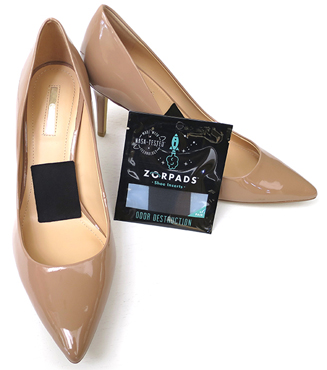
This is the story of a space-age insert for shoes that got its start when a graduate student with smelly feet took off her shoes and another tapped into his aerospace experience to solve the problem.
The result was Zorpads, shoe inserts that use an extremely porous activated carbon cloth to absorb odor. The inserts also work in gym bags, trash cans, and other foul-smelling places, the company said.
Activated carbons are used in all crewed spacecraft to condition the atmosphere for breathing and for odor control, for example, in toilet filters, according to Jay Perry, who works on filtration technologies at NASA’s Marshall Space Flight Center in Huntsville, Alabama.
“There is a rich and long history of using activated carbons for these applications going back to Project Mercury,” Perry said, referring to NASA’s first human spaceflight program in the late 1950s and early ’60s.
Spacecraft cabins are relatively small, enclosed spaces with equipment and people releasing a host of contaminants that must be mitigated. Activated carbons are often part of standard filtration systems, both on Earth and in space.
In most of its applications, NASA uses granular activated carbons, usually made from coconut shells brought to very high temperatures without oxygen to create a char — a process known as pyrolysis.
The activated carbon cloth that Zorpads uses is unique in that it is made from a viscose rayon material derived from wood pulp. Unlike some activated carbon cloths, which are created by applying carbon to a non-carbon cloth, this material is 100% carbon.
In 2015, NASA compared a few different cloths to several granular activated carbon formulations as part of research into removing contaminants called siloxanes from the International Space Station. Used in plastics, like printed circuit boards, siloxanes are released into the atmosphere through offgassing.

In filtration systems, activated carbon cloth can allow atmosphere to pass more easily at high flow rates than packed granular carbon. The NASA team, including Perry, wanted to know if multiple layers of activated carbon cloth, one on top of another, could absorb and filter siloxanes as well as granular carbon without causing more flow resistance.
For that application, the granular carbon outperformed the cloths and became NASA’s choice for use aboard the International Space Station. But the cloth Zorpads would use was still shown to be extremely absorbent, making it ideal in other situations, including as dressing for wounds. And now feet, too.
Before attending Harvard Business School, where he and four other classmates developed Zorpads as part of an assignment, Taylor Wiegele had worked with activated carbons during stints at the water-purifying company Brita and at SpaceX, where he consulted with NASA engineers, including Perry, on spacecraft atmosphere purification.
“I came across a number of really interesting materials, and this one kept staying in my mind,” Wiegele said.
“Later when I started to develop the shoe insert, I realized this was the perfect material for that application,” he said. “NASA had done a lot of testing on it, and those results helped us identify it as the right material from the outset.”
To the business school study group’s surprise, the project won accolades.
Wiegele and one of the classmates, Sierra Smith, incorporated the company in New York in 2016 and went on to win a $150,000 investment on “Shark Tank,” the business reality TV show where entrepreneurs pitch their ideas to investors.
Wiegele and Smith currently both hold full-time jobs elsewhere, but they still promote and improve on Zorpads as they can. They have developed more effective adhesion to keep the inserts in shoes, for instance, and determined better recommendations for where to place the patches in different types of shoes.
There were already options available to keep odors from shoes, but Wiegele, Smith, and their classmates found they either didn’t work well or they were too bulky for a lot of shoes, or they bunched up and became uncomfortable.
With the help of a material that NASA has also explored for purifying cabin atmosphere in space, Zorpads aims to solve all these problems and be, in Wiegele’s words, “much more effective and better than all the other technologies that are on the market.”
NASA has a long history of transferring technology to the private sector. The agency’s Spinoff publication profiles NASA technologies that have transformed into commercial products and services, demonstrating the broader benefits of America’s investment in its space program. Spinoff is a publication of the Technology Transfer program in NASA’s Space Technology Mission Directorate.
For more information on how NASA brings space technology down to Earth, visit: spinoff.nasa.gov





